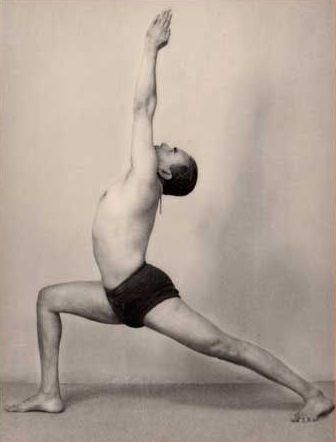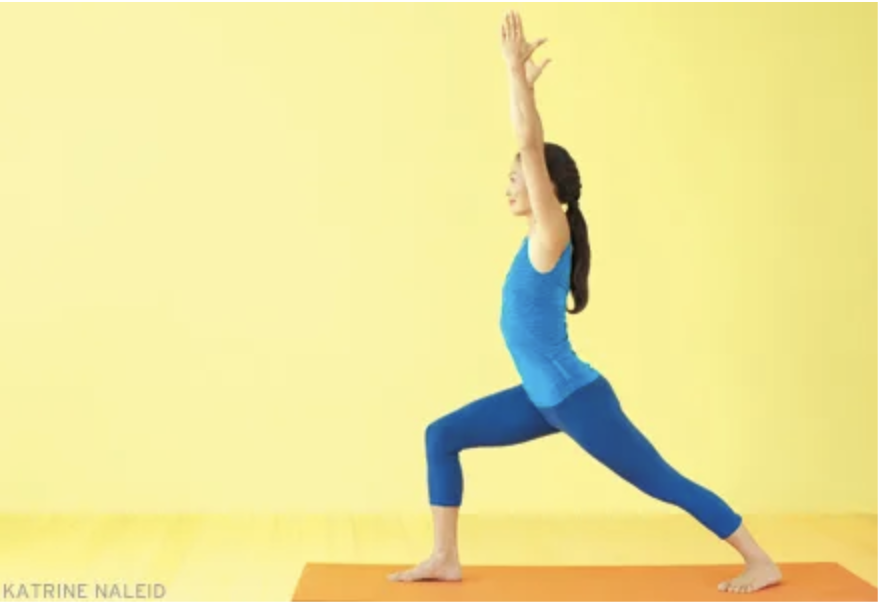How Spinefulness changed my Warrior I from fierce to friendly

I don’t remember when Warrior I popped up in my first set of introductory yoga classes, but I do know that by the end of that eight-week session, we had met, and we weren’t friends.
As years went by, I learned to tolerate the pose, but I never looked forward to it coming up in class, and was always glad when we moved on. Warrior I was tippy, especially if I tried to drop my head back. It was taxing, especially on my thighs. And it was heavy. I struggled to lift my body weight against the pull of gravity, and came out of the pose more tired than energized.
At the time, I believed that if I just kept practicing with the correct cues, I would grow stronger, in the same way that lifting weights in the gym makes you stronger. I would build muscle where I needed it.
Since I was taking Iyengar yoga classes, I learned plenty of cues for Warrior I. But my teachers stressed two instructions above all. First, to lengthen the buttocks away from the waist, to protect the lower back from compression. You can’t do that without lifting the front of your pelvis. And when you do, you’ll feel your belly tighten.
The second was to create a big open chest by extending up the front body and lifting the chest.
The problem is that these cues usually create a pose with a long lumbar curve, and ribs that poke forward.
Check the picture of BKS Iyengar above, and you will see lifted buttocks and a short, sharp arch at the waist, supporting a long straight spine. Why does it matter? Because lifting the front of the pelvis and the front chest take us out of natural alignment. The photo below is Warrior I in modern posture.

(These cues, by the way, are used in many yoga forms, not just Iyengar. The photo above comes from an instructional website for Vinyasa yoga. The instructions for the pose include: “contract your abdominal muscles in order to tilt your pelvis so your tailbone moves down and under,” and “hold your posture tall, feeling your ribcage lift away from your pelvis.”)
As a dutiful student, I practiced Warrior I with my buttocks down and my chest lifted and I did become stronger. But the pose remained tippy, taxing, and heavy. When I eventually began to teach, I taught it from a sense of duty, not delight.
Then Spinefulness intervened.
At first, I took a vacation from my yoga practice. When I began to integrate my new alignment into my poses, something odd happened. I started practicing Warrior I out of curiosity. It was as though an acquaintance I didn’t much like had popped up in a new context and turned out to be fascinating.
I have new cues, and my new cues give me new results.
Now, I roll my pelvis forward until it sits up and over my femur heads. And instead of lifting my front body, I soften my front ribs and let them descend. When I bring my arms up, I move my front ribs down more strongly, as though they were chasing my hip creases. Then, following B.K.S. Iyengar’s instructions from Light on Yoga, I stretch my spine from my tailbone all the way up my back.
When I work this way, I feel more stable, mostly because of a wall of abdominal muscle that moves in and up when I roll my pelvis forward and keep my front ribs down.
To be clear: I don’t “activate my abdominals.” I don’t move these muscles, nor do I “work” them. When my bones are in place, they just show up and support me.
How is this different from the belly tightening that happens when you lift the front of your pelvis?
The sensation from being in natural balance is broader and deeper. It’s not just a tightening, but also a lift. After a few moments, the tightening that comes with lifting the front pelvis begins to tighten the low back as well. The lift from dropping the rib cage and letting the pelvis drop forward moves into the lumbar spine and relaxes it.
In fact, the whole pose feels lighter. And when I come out, I feel energized and not exhausted. Better still, it feels like practicing Warrior I makes it easier to live the rest of my life in the gravitational line.
I would never claim that I look like BKS Iyengar when I practice Warrior I, although that remains my aspiration. A lifetime of tucked buttocks and lifted ribs isn’t going to vanish overnight. I’m still learning to maintain my natural arch, for one thing, so my torso is tilted slightly forward, instead of vertical. And I no longer lock my back knee: a straight knee stops my pelvis from rolling forward.
But the deepest change is less physical, and more pervasive.
I no longer think of getting stronger by building muscles. I believe that if I place my bones on the gravitational line, and let my muscles relax, they will strengthen. A tight muscle, after all, is a weak muscle, because it has no capacity to contract.
As long as I’m on the line, I can practice not only on my mat, but every time I go for a walk, especially uphill, or climb a flight of stairs, or load the dishwasher. The muscles that need to work will work. And they’ll be there for me in my next yoga practice, which might very well include Warrior I.
If you’d like to learn how Spineful alignment might bring new ease to your yoga practice, please join me for my Spineful Yoga Weekend Workshop, November 15, 16 and 17. Click on this link for more details: https://spinefulness.ca/event/spineful-yoga-weekend-workshop-with-eve-johnson/
The workshop is limited to 10 students, so if you’re interested, let me know at evej@shaw.ca